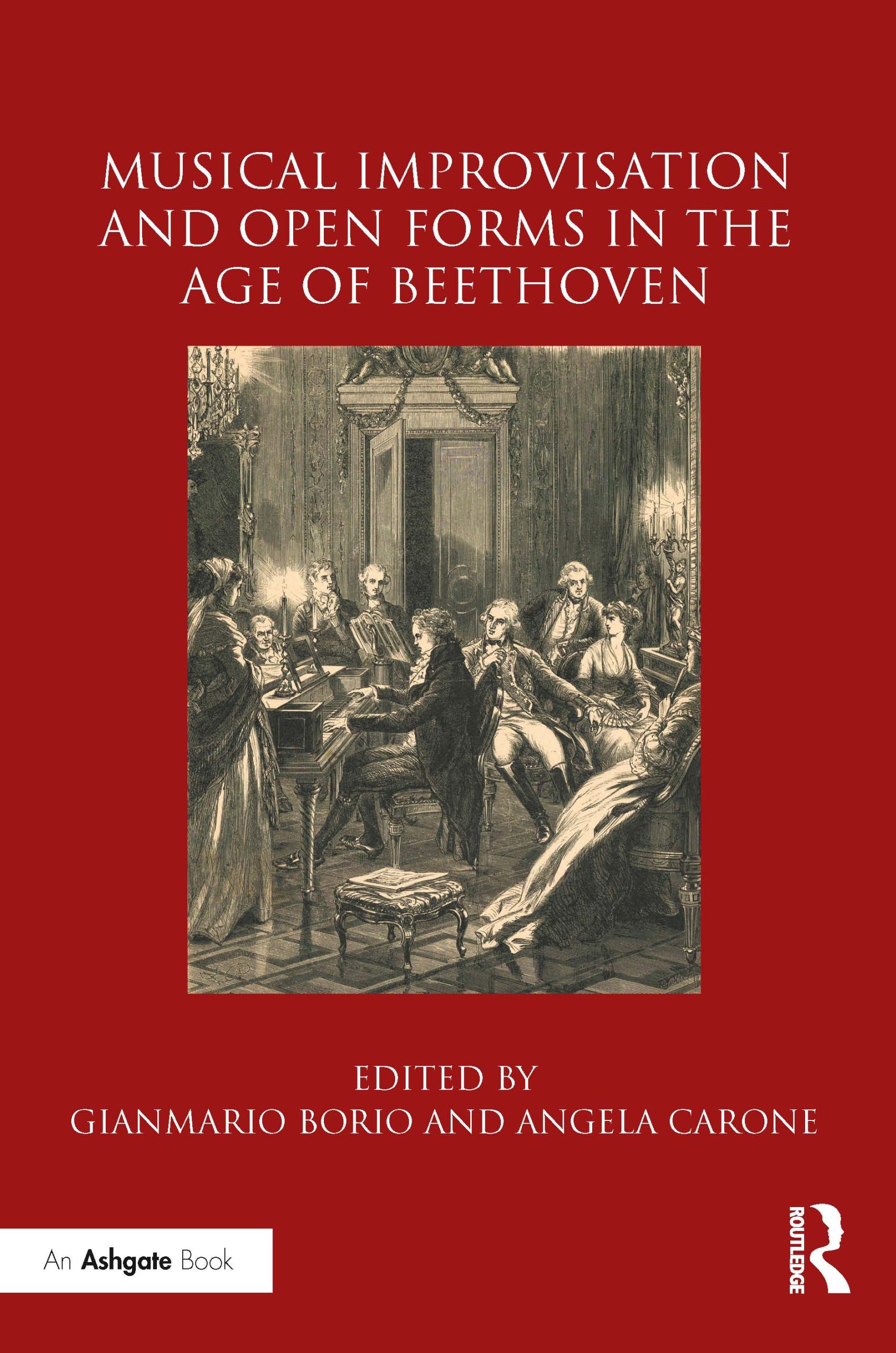
Musical Improvisation and Open Forms in the Age of Beethoven
Edited by Gianmario Borio and Angela Carone
Routledge, Abingdon, 2018
Improvisation was a crucial aspect of musical life both on public occasions and in the private lives of many composers in Europe from the late 18th to the mid-19th century. It also had unexpected, important points of crossover with compositional practice. The writers in this book of essays explore the many facets of the phenomenon, demonstrating how composers, often as concert performers, at times structured improvisations in a similar way to that found in pieces written in predetermined forms; at other times, during public performances they complied to precepts concerning how to play “good” improvisations contained in theory or teaching handbooks. On the other hand, the formal syntactic freedom found in some compositions may often be interpreted as the equivalent on the written page of a typically extemporaneous performative practice. The ways in which this constant interweaving of improvisation (instrumental and vocal) and formal organisation has developed is investigated in twelve chapters with the aid of many, varied sources: autograph manuscripts, musical theory treatises, scores, reviews, letters, biographies and autobiographies.
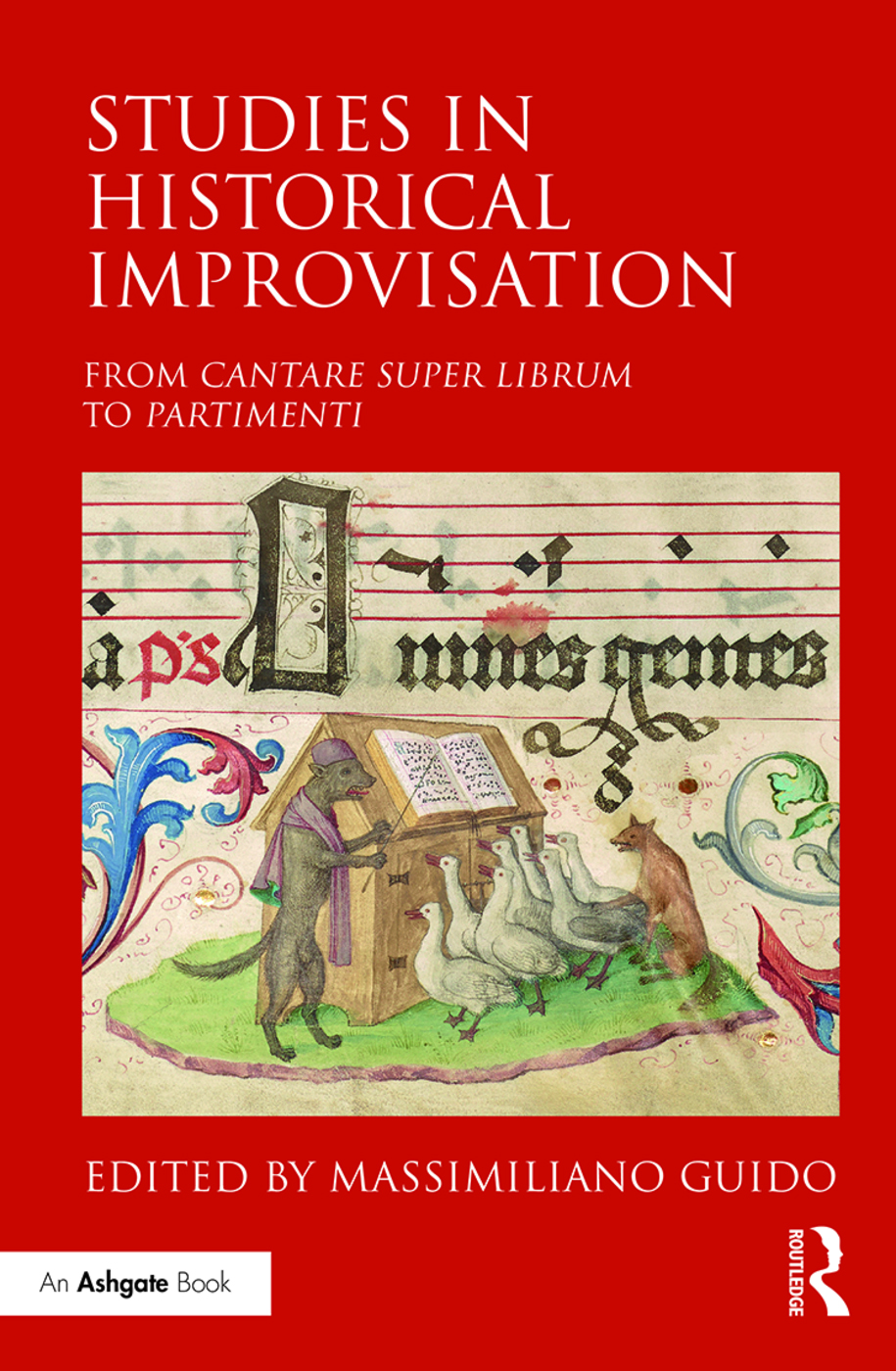
In recent years, scholars and musicians have become increasingly interested in the revival of musical improvisation as it was known in the Renaissance and Baroque periods. This historically informed practice is now supplanting the late Romantic view of improvised music as a rhapsodic endeavour – a musical blossoming out of the capricious genius of the player – that dominated throughout the 20th century. This book provides the first systematic exploration of the close relationship between improvisation, music theory, and practical musicianship from the late Renaissance into the Baroque era. It is not a historical survey per se, but rather aims to re-establish the importance of such a combination as a pedagogical tool for a better understanding of the musical idioms of those periods. The authors are concerned with the transferral of historical practices to the modern classroom, discussing new ways of revitalising the study and appreciation of early music. The relevance and utility of this kind of an improvisation-based approach also changes our understanding of the balance between theoretical and practical sources in the primary literature, as well as the concept of music theory itself. Through its various sections, the book explores the path of improvisation from theory to practice and back again.
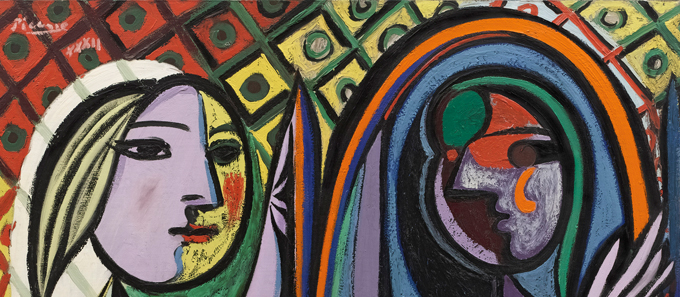
The female voice embodies several aspects of the contemporary world and studies on the subject
require a multidisciplinary approach. Coordinated by Michela Garda and Serena Facci,
this conference will investigate the importance of the material, symbolic and aesthetic dimensions
of the female voice. The first session will be dedicated to theoretical thinking arising from
the impact of vocal and compositional practices; the second will deal with the role of the voice
in musical theatre in terms of compositions and performances; the third will focus on vocal
experimentation and the extension of expressive possibilities; and the fourth will explore the
“grain of the voice” and new vocal timbres, by comparing experiences in experimental composition,
popular music and jazz.
On the second evening of the conference there will be a conversation between Stefano La Via
(University of Pavia) and the singer Maria Pia De Vito, followed by musical demonstrations in
which she will be accompanied by the pianist How Warren.
DOWNLOAD THE PROGRAM
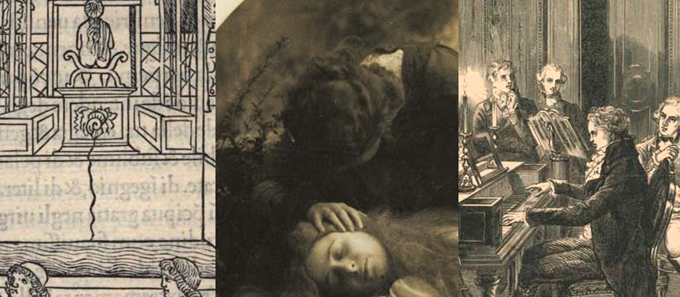
Books at San Giorgio, a series of meetings presenting the latest publications concerning or by
the Fondazione Cini, has now reached its thirteenth edition.
On 13 March the latest volume of Studi Veneziani (for the year 2016) will be presented. Edited by the Institute of the History of the Venetian State and Society, this journal explores the manifold aspects of over a thousand years of Venetian history.
On 20 March, the featured book is Il teatro in fotografia. L’immagine della prima attrice italiana fra Otto e Novecento by Marianna Zannoni. This study of leading ladies in Italian theatre at the turn of the 20th century focuses on great divas (Adelaide Ristori, Eleonora Duse and Tina Di Lorenzo) and the way that they were portrayed in a system popularising images and creating myths capable of influencing social customs.
The series will end on 23 March with two books produced by the Institute of Music: Musical Improvisation and Open Forms in the Age of Beethoven edited by Gianmario Borio and Angela Carone, and Studies in Historical Improvisation. From Cantare super Librum to Partimenti edited by Massimiliano Guido. The first book explores the central role of improvisation in both public occasions and the private lives of many artists from the late 18th and to mid-19th century, while the second book deals with the study of improvisation as theorised and practiced from the 16th to the 20th century.
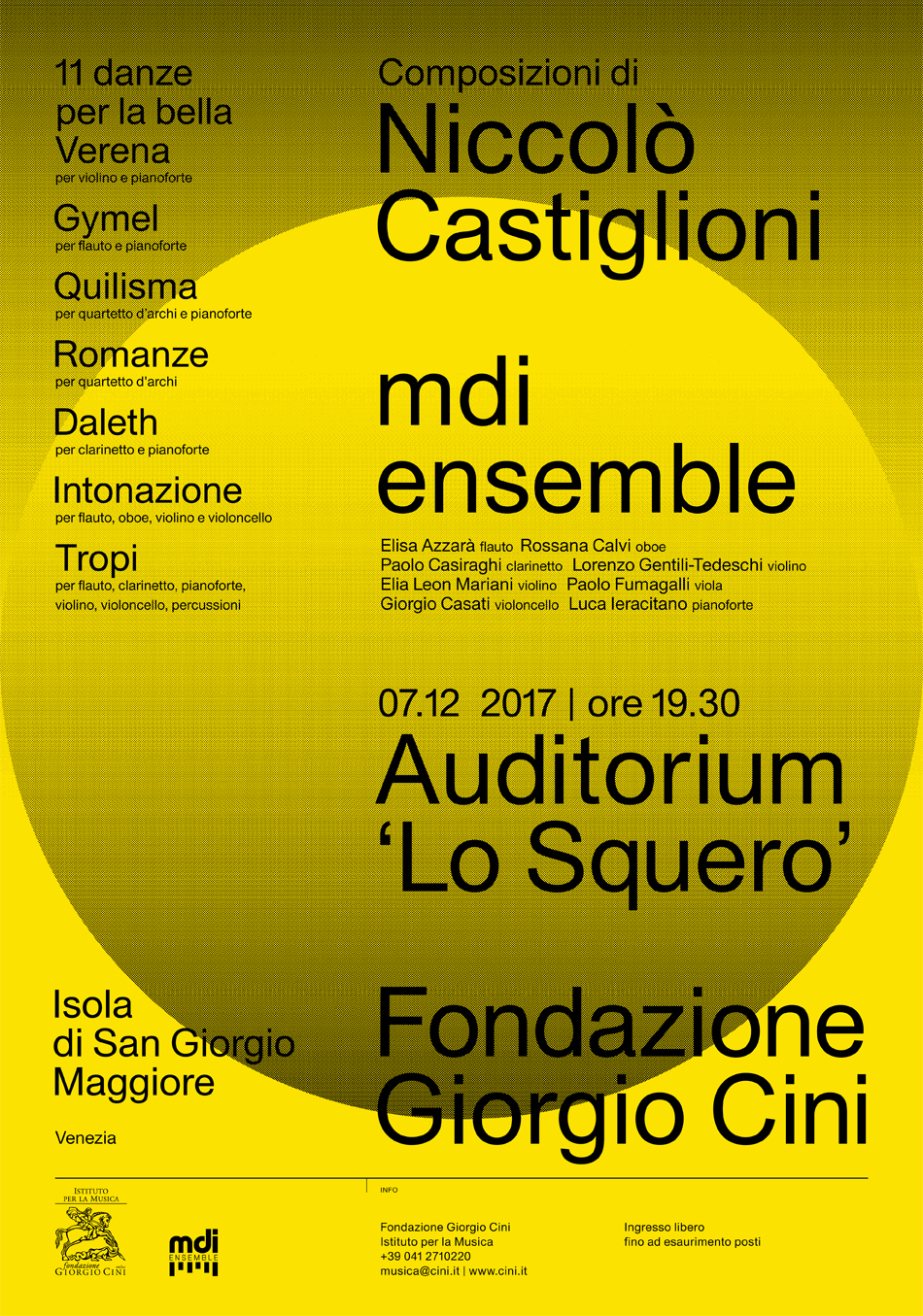
Concerts and the performing arts 7 December 2017
A concert of music by Niccolò Castiglioni
Venice, Island of San Giorgio Maggiore
7 December, 7.30 pm
The Squero Auditorium
Fondazione Giorgio Cini
At 7.30 pm on 7 December at the Squero Auditorium – following the presentation of the book Music-Dance: Sound and Motion in Contemporary Discourse – the Institute of Music pays homage to composer Niccolò Castiglioni with a concert by the mdi ensemble.
The concert features some of the most significant compositions by Castiglioni, whose music archive has recently been acquired by the Institute of Music.
Free admission while seats last
DOWNLOAD THE PROGRAMME
CONCERT PROGRAMME
11 dances for the “bella Verena”
for violin and piano
Gymel
for flute and piano
Quilisma
for string quartet and piano
Romances
for string quartet
Daleth
for clarinet and piano
Intonation
for flute, oboe, violin and cello
Tropes
for flute, clarinet, piano, violin, cello and percussion
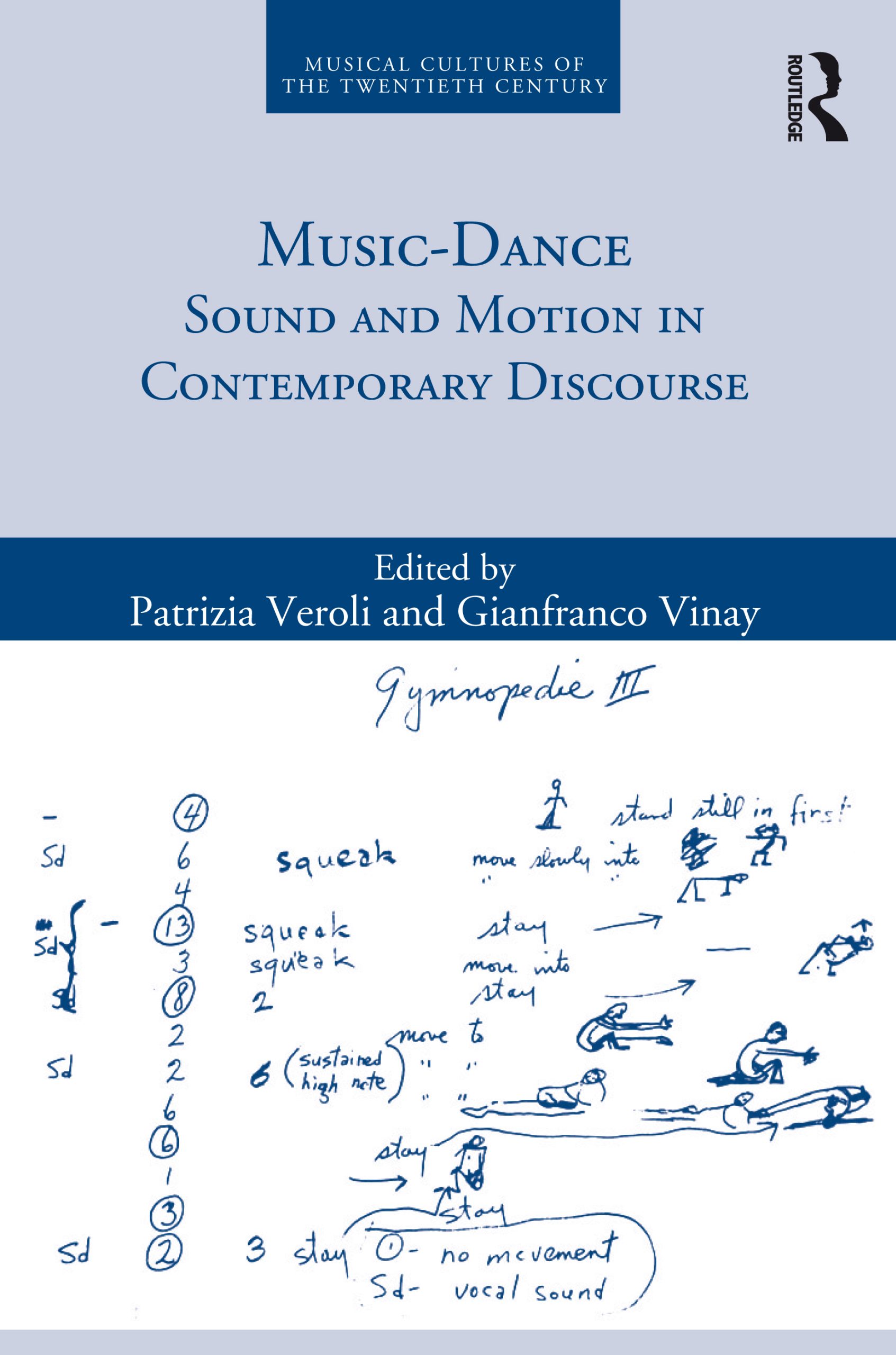
Book presentation. Music-Dance: Sound and Motion in Contemporary Discourse
Venice, Island of San Giorgio Maggiore
7 December, 5 pm
Sala del Consiglio
Fondazione Giorgio Cini
On 7 December, the Institute of Music is launching the third volume in the “Musical Cultures of the Twentieth Century” series, entitled Music-Dance: Sound and Motion in Contemporary Discourse, edited by Patrizia Veroli and Gianfranco Vinay, and published by Routledge, London.
The two editors will present the book, together with Gabriele Brandstetter (Freie Universität, Berlin) and Anthony Gritten (Royal Academy of Music, London).
The book explores the nature of choreomusical work, its complex authorship, the cognitive processes in dance performance and its modes of reception. Scholars of dance and music analyse the ways the musical score changes its prescriptive status when part of a choreographic project, the encounter between sound and motion on stage and the intersection of listening and sight in the act of reception.
At 7.30 pm in a concert at the Squero Auditorium, the mdi ensemble will perform music by Niccolò Castiglioni, whose archive has recently been acquired by the Institute of Music.
Articles
- Elia Andrea Corazza, Opera or ballet? Ottorino Respighi vs. Sergei Diaghilev: a Study of the Sources for «La Boutique fantasque», «Le Astuzie femminili» and «La Serva padrona»
- Tobias Reichard, “Malipiero Germanised“ Traces of Cultural Usurpation in Nazi Germany
- Angela Carone, Alfredo Casella and Giovanni Salviucci. The Story of a Friendship Told Through Archival Documents
- Susanna Pasticci, Hermeneutics and Creative Process: Roman Vlad’s Reception of Stravinsky
- Marco Cosci, Vancini, Macchi and the Voices for the (Hi)story of Bronte
- Simone Caputo, An Attempt at Creating Total Theatre: «Scene del potere» by Domenico Guaccero
- Giacomo Albert, Some Remarks about Serialism in «Atomtod» by Giacomo Manzoni
Documents and Reports
- Paolo Valenti, Aurél Milloss’s and Nino Rota’s «Rappresentazione d’Adamo ed Eva»: Archival Documents
- Angela Carone, Publications and Activities
The second issue of Archival Notes is available for download and consultation on the OJS platform of the Fondazione Giorgio Cini.
Music-Dance: Sound and Motion in Contemporary Discourse
Edited by Patrizia Veroli and Gianfranco Vinay,
Volume 3 of “Musical Cultures of the Twentieth Century”
Routledge, London, 2017
Music-Dance explores the nature of choreomusical work, its complex authorship, the cognitive processes in dance performance and its modes of reception. Scholars of dance and music analyse the ways the musical score changes its prescriptive status when part of a choreographic project, the encounter between sound and motion on stage and the intersection of listening and sight in the act of reception. The authors of the essays also include representative specialists of “choreomusicology”, historians of dance, scholars of 20th-century composition, and experts on the cognitive sciences and performance. The main thematic areas are: the relationships between sound and motion in dance performance; the notational practice of choreographers and
the parallel attempts of composers to find a graphic representation for musical gestures; the experience of dance as a paradigm for multimodal perception; and notation, multimedia and the analysis of performance.
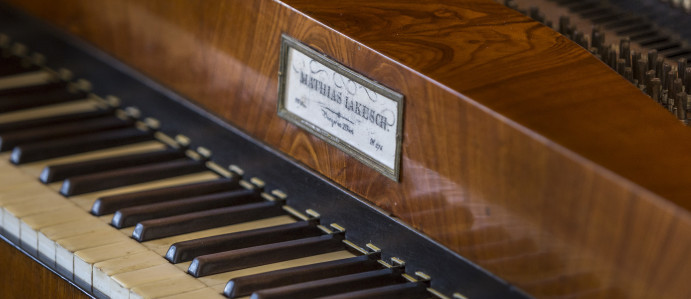
By exploring two late Schubert sonatas (D 894 in G Major and D 959 in A Major), this seminar is a scholarly complement to the recording currently being made by Paolo Zanzu on the Matthias Jakesch fortepiano in the Fondazione Giorgio Cini. Mario Carrozzo, Alessandro Cecchi and Cesare Fertonani, together with the pianist, will discuss, the most important aspects of the two sonatas from Schubert’s late period. On the basis of various analytical approaches, they will highlight the impact of analysis on performance. There will also be a focus, however, on the history of interpretation and the prerogatives of performing on period instruments. In fact, reflecting on performances on period instruments can have important repercussions on musical analysis. The working background to the seminar is the “Theory and
Practice of Music Interpretation”: a systematic set of studies and seminars devoted to specific aspects of various repertoires, whose common denominator is the reference to historical sources, seen both as a reflection of performance practice in treatises on the subject and as audio and video documentation. It also establishes a link with the Research-Led Performance series, which the Institute of Music has organised mainly with performers in mind for the purpose of increasing awareness of the history of musical texts and their interpretations over time.

Books at San Giorgio, a series of meetings presenting the latest publications concerning or
published by the Fondazione Cini, will resume this autumn.
At the first meeting, on 4 October, the featured book is La giovinezza di Tintoretto, containing
the proceedings of the conference on Jacopo Tintoretto, the great Venetian painter considered
to be one of the most original Mannerist artists, ahead of the fifth centenary of his birth.
The second date, October 10, will be devoted to the presentation of La scena di Mariano Fortuny.
Atti del Convegno Internazionale di Studi, edited by Maria Ida Biggi, Claudio Franzini, Cristina
Grazioli and Marzia Maino. The book contains the proceedings of the conference on Mariano
Fortuny y Madrazo’s theatre work and poetics, held in Padua and Venice in November 2013.
Scholars and experts explore the work of the multi-faceted Spanish artist, such as his experiments
with stage lighting and stagecraft, and his relations with the great early 20th-century
directors and leading figures in the fields of dance, the visual arts, music and photography.
The last date, on 18 October, will see the launch of two online books by the Institute of Music:
Variazioni in sviluppo. I pensieri di Giovanni Morelli verso il futuro, edited by Giada Viviani,
and Teatro di avanguardia e composizione sperimentale per la scena in Italia: 1950-1975, edited
by Gianmario Borio, Giordano Ferrari and Daniela Tortora.







